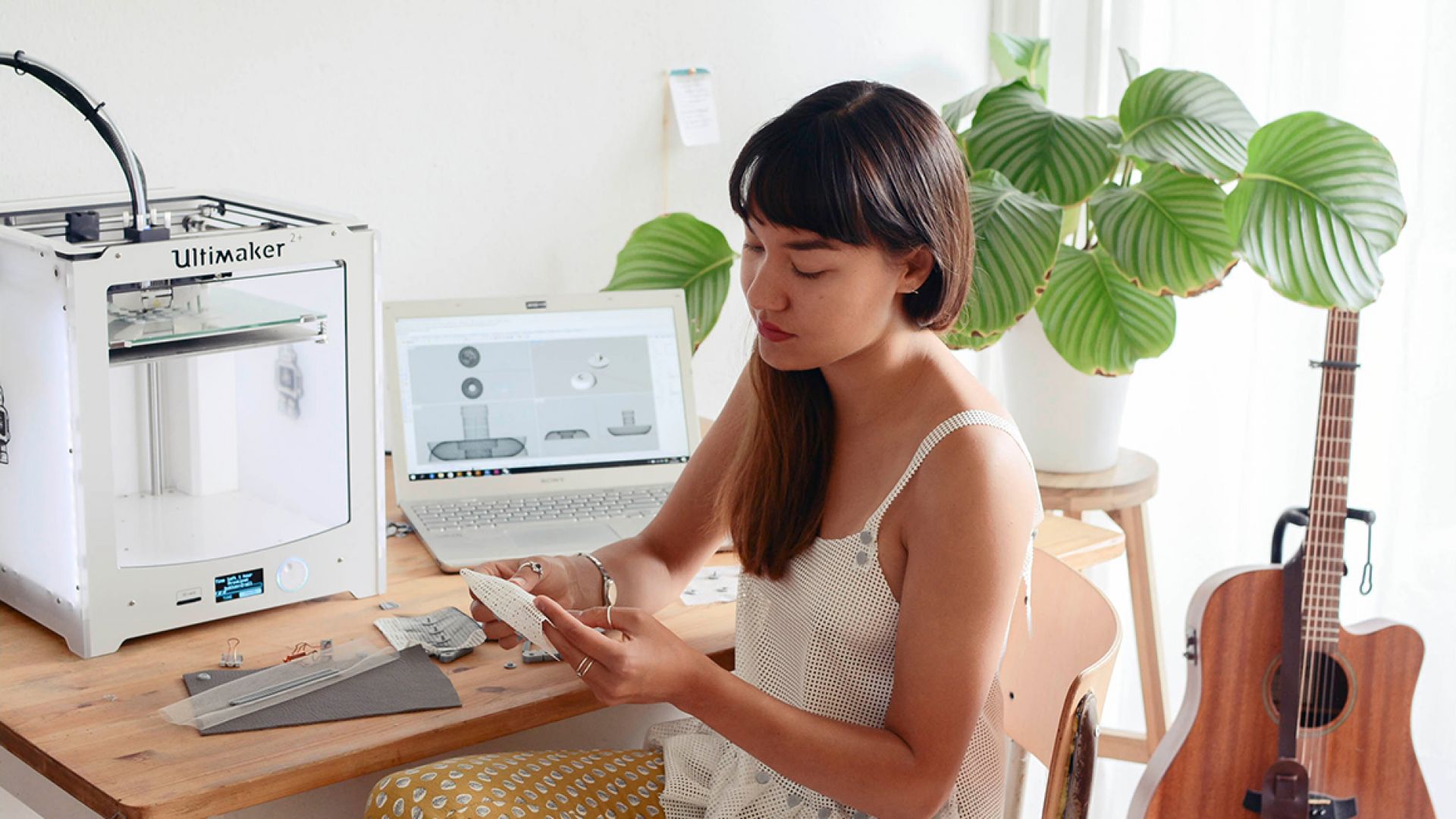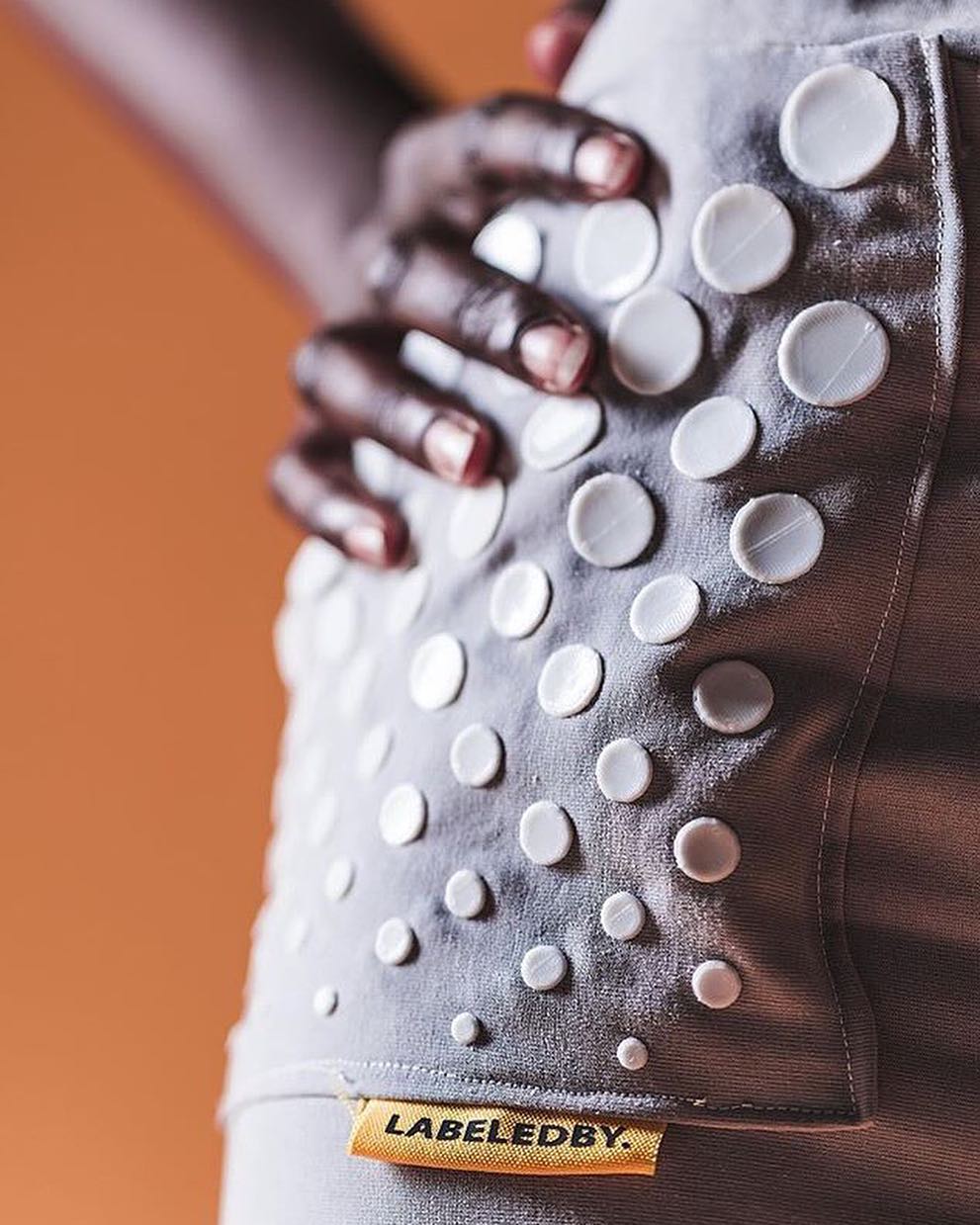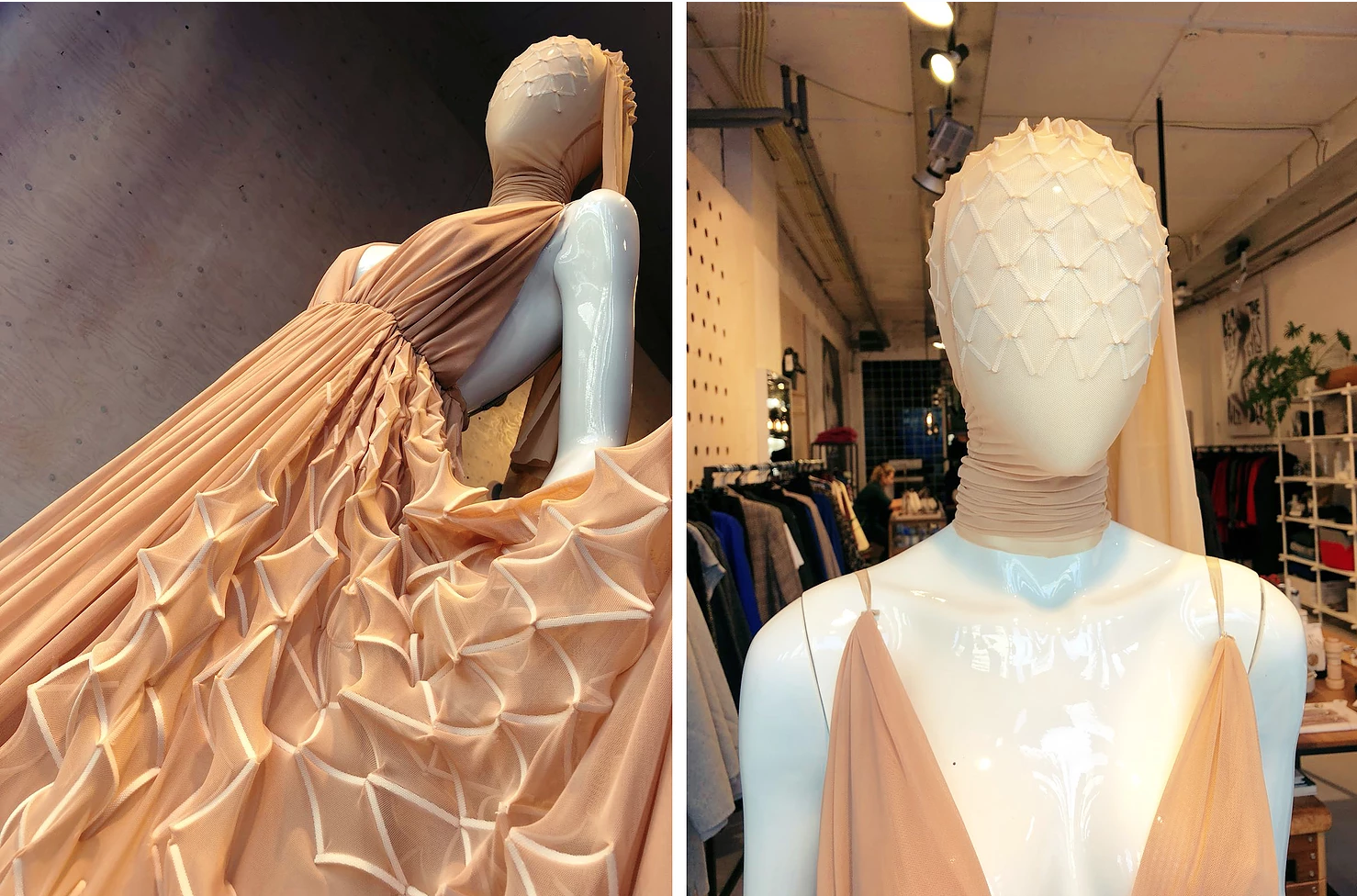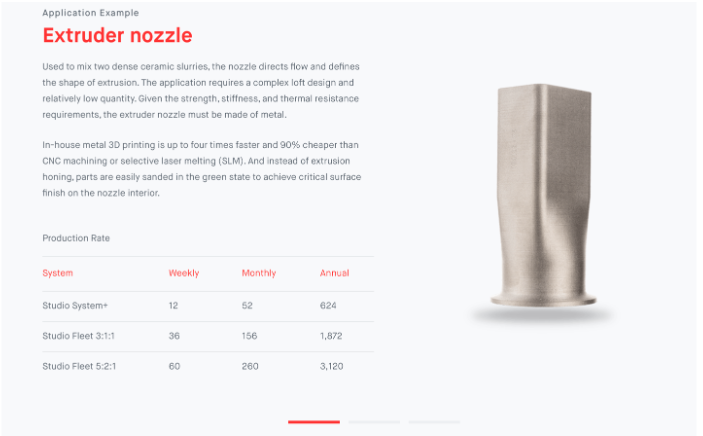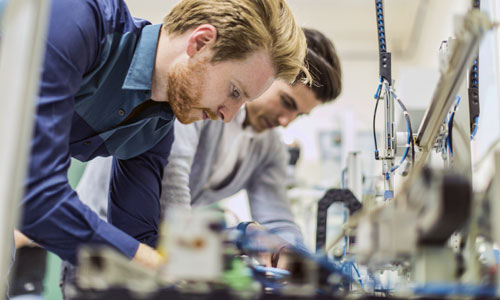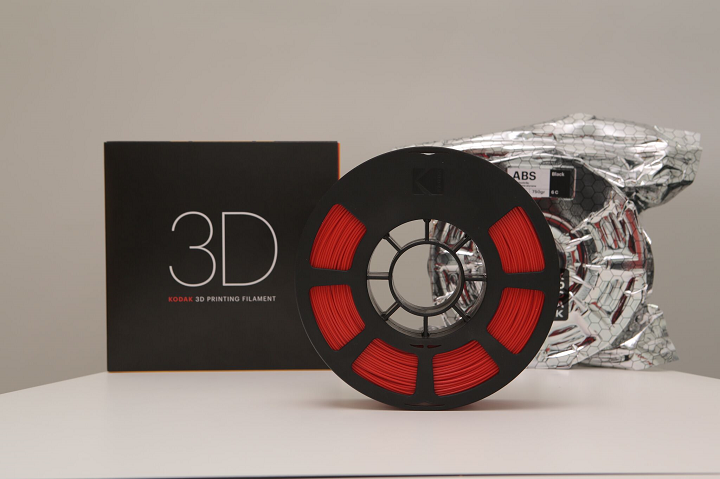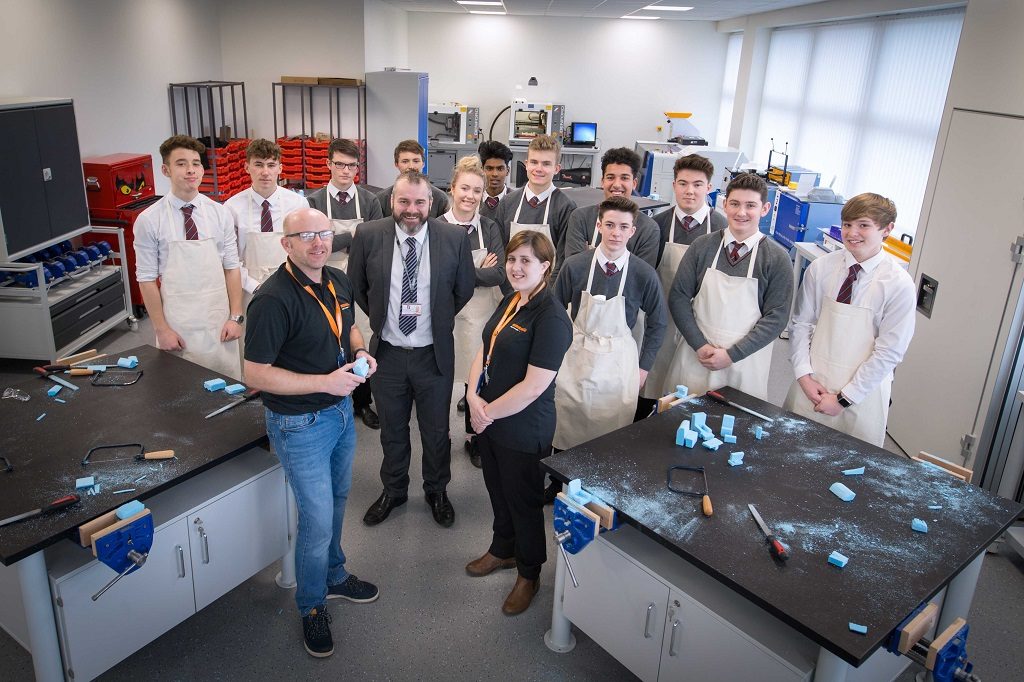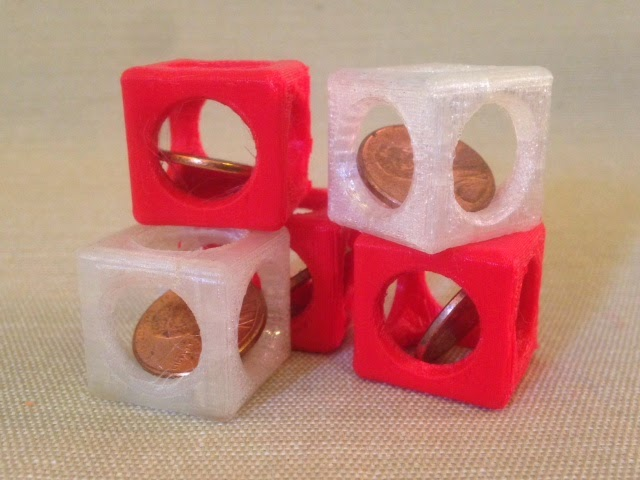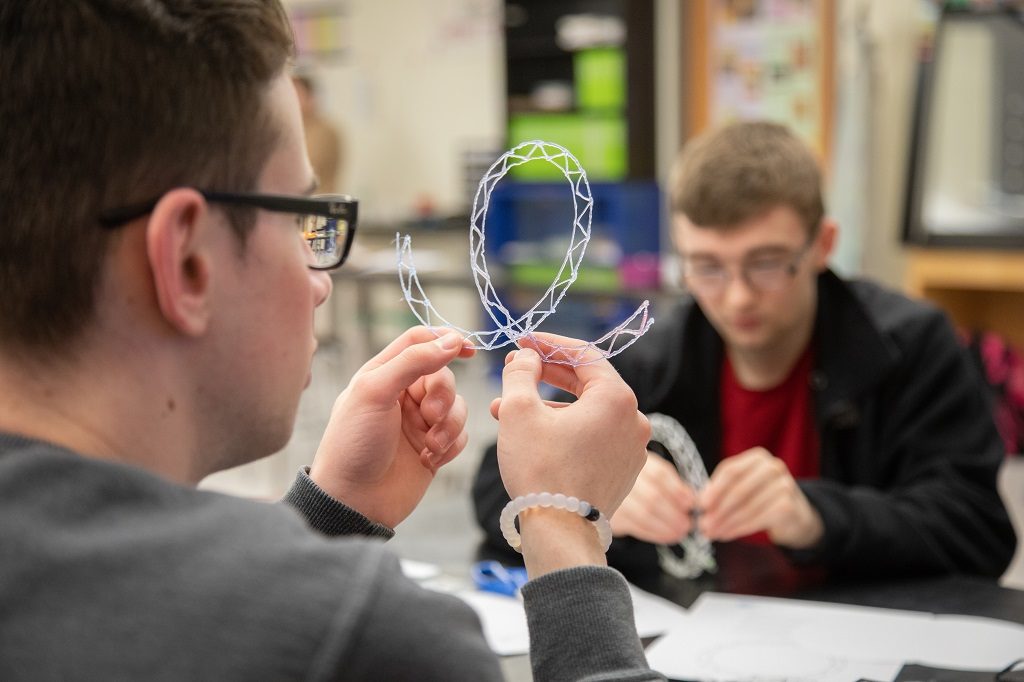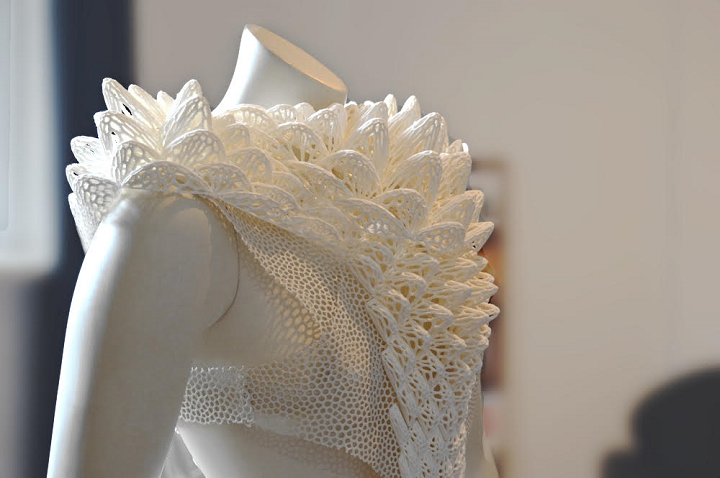Leading industry stakeholders to develop roadmap for 3D printing in lighting, building, and construction
The Future of 3D Printing and Fashion Design Through the Eyes of LabeledBy
LabeledBy is a design studio based in Eindhoven, the Netherlands. They work in fashion and their area of expertise is research and technology development. Their products range goes from technological textiles to innovative couture. As engineers with master degrees from the Technical University of Eindhoven, they are able to explore the future of fashion and adapt innovative methods to fashion design that bring the craft of clothing forward.
In their own words, here is their mission:
We strive for a personalised, localised and sustainable fashion industry. Therefore it is our mission is to transform the fashion industry through innovation and technology. We develop new textiles that are relevant for a diverse range of applications, and research alternative digital manufacturing systems for textiles and garments. These systems have the ability to automate labor intensive and dangerous processes, improving worker safety and wellbeing. Next to that, these digital manufacturing systems encourage on demand and personalised production of garments, resulting in less waste and more value for the customer.
The use of 3D printing in fashion is creating an optimistic path towards the future of textile and clothing. What is presented nowadays as exclusive showpieces could be a possibility at hand for everybody in the future. As one of the most important features of 3D printing, the possibility of have a personalised garment that fits each body perfectly by being unique makes us impatient to see the future of fashion design.
LabeledBy is a studio that has placed its bet in this direction. They offer a future-oriented service of trend research, textile development as well as the making of exclusive showpieces. With an in-house production, they have the possibility of personalise each project and develop it in terms of manufacturing techniques and material. They work with a 3D printer that prints directly on textile, being able to create form small samples to big garments. Starting with an Ultimaker that they then modified the team is now continuing to develop their own print methods.
I reached out to LabeledBy to interview Fabienne van der Weiden and Jessica Joosse on their chosen craft.
How does your 3D printer work?
The principle of the 3D printer is comparable with an FDM printer, however, it is redesigned and optimised for 3D printing garments and textiles.
What materials can it print?
The printer prints all the materials (filaments) currently available on the market. We are constantly tweaking the machine so it can also print with more experimental and biodegradable materials.
How would I work with you if I was a fashion designer?
With our manufacturing technique, the sky’s the limit in terms of design and materials! Fashion designers can make use of our pre-developed textiles or can collaborate with us to develop new textiles which will be implemented in the final design that can be printed on our 3D printer.
Why is what you do important?
FashionTech is there to explore and form the future, in anticipation of current society and its culture. By implementing technology in fashion we can make clothes on the edge of the existing framework and approach the state of the art from unknown perspectives. By doing this, we are able to create a culture in which society is encouraged to discuss the future of the fashion industry.
What is the added value of what you do?
We believe that fashion is not only perceived as functional, it also has the ability to show someone’s identity. Therefore garments could become much more personal, both in fit as in expression. Using technology during the process of creating a garment gives us the possibility of making the garment more personal and unique.
What are you adding to the 3D printing & fashion world?
The combination of digital generated personalized patterns (through for example AI) and digital manufacturing techniques gives us the possibility of easily changing the design of each garment without additional costs or long setup time. This gives fashion designers and fashion brands the possibility to efficiently adapt and personalize their garments to the fast-changing needs of their customers. We actually believe that this can give the fashion industry a lot of freedom and benefits when applied correctly!
What do you think about the future of 3Dprinting & fashion?
We believe strongly that consumers’ search for unique and sustainable consumption experiences will gradually drive the emergence of a different paradigm. Such a paradigm will require new technologies for consumer-driven design, new production methods for flexible, efficient and local on-demand production down to lot size one. And of course a seamless network of designers with different fields of expertise, working with these new technologies in an open-source community. We are excited for the future of fashion!
Can you actually wear the garments? Can you clean them in a washing machine?
Absolutely! Check our Instagram. Currently, our garments are worn by performers and artists. Yes, that’s not a problem! We use materials that are suitable to wash in a regular washing machine.
Personally, I do believe that 3D printing has a lot to offer the fashion world. Given my experience with developing 3D printing filaments as an engineer, I’m skeptical about the real-life wear and washability of 3D printed garments today. But, I’m sure that motivated people like Fabienne & Jessica will get us there in the end. We are at the beginning of a long path whose end requires a creative mind to foresee. The difficulties are in imagining a future of 3D printing in fashion which itself creates new aesthetics that still feel futuristic to us. As a designer, this idea of new aesthetic tinkles my mind. I’m excited to see the work of studios like LabeledBy which help us to envision the future of 3D printing and fashion through their dedication.
TCT Asia: Ultimaker Introduces Cloud-Based Platform and New 3D Printing Material Alliance Program Partners
The TCT Asia show began today in Shanghai, and desktop 3D printing leader Ultimaker is one of the attendees. The Dutch company made some important announcements at the event today, including the launch of its future-ready Ultimaker Cloud platform, which was designed to support the professional 3D printing workflow and will help speed up the adoption of 3D printing.
As the world transitions to local digital manufacturing, we need a platform solution that will not only make the user workflow more simple but also hasten this transition, while ensuring compatibility with multiple materials and software applications. Due to Ultimaker’s open strategy, important industry partners, like material manufacturers and CAD providers, can integrate with its new cloud-based platform, which will offer more value to users and make the 3D printing experience seamless and reliable.
“Ultimaker Cloud forms the foundation for future value propositions provided by Ultimaker and key industry partners. This is a crucial next step in our journey to speed up the world’s transition to local digital manufacturing,” said Jos Burger, Ultimaker CEO. “I have no doubt that our enabling platform, formed with our global network of software and material partners, makes Ultimaker the preferred solution in the desktop space.”
The first cloud services the platform offers include remote 3D printing, which will provide monitoring and allow print jobs to sent from anywhere to network-enabled Ultimaker 3D printers. Ultimaker Cloud also provides unlimited access to the Marketplace, where registered users can browse materials thanks to exclusive access to print profiles, as well as give feedback to the community and plugin contributors through a rating option. In addition, optimized settings for ideal print results are automatically populated in Ultimaker’s Cura software through the Marketplace. Finally, Ultimaker Cloud offers a way to backup user settings for easier remote access.
 Ultimaker Cloud will be available for download on March 19th, which is also when Ultimaker Cura 4.0, with its updated user interface, will be launched.
Ultimaker Cloud will be available for download on March 19th, which is also when Ultimaker Cura 4.0, with its updated user interface, will be launched.
This new cloud-based platform isn’t the only news Ultimaker announced at TCT Asia. The company’s Material Alliance Program, which was established last year, has three new members: Polymaker, eSUN, and Essentium.
“The growing importance of 3D printing gives us – as a leader in desktop 3D printing – an important role in ensuring a perfect collaboration between hardware, software and materials. By offering material profiles directly to millions of end users via the Ultimaker Marketplace, we unlock new 3D printing applications for different industries,” said Burger. “Essentium, eSUN, and Polymaker and are well-respected material companies, offering unique material properties that are relevant for engineers working in a wide range of industries. I am proud to recognize their commitment to the Ultimaker Material Alliance during TCT ASIA.”
This means that there will now be more choices for applications and materials in FFF 3D printing, as print profiles for these three companies will now be available for download in the Ultimaker Marketplace. Users can just choose a material profile and quickly begin a print.
“FFF 3D printing remains the most practical and accessible of all 3D printing technologies. The three materials we offer via the Ultimaker Marketplace, including PolyMide PA6-CF, PolyMide CoPA and PolyCast, are among the most unique and advanced materials in our portfolio,” stated Polymaker president Dr. Xiaofan Luo. “I believe they will open up countless new applications for a greater number of engineers.”
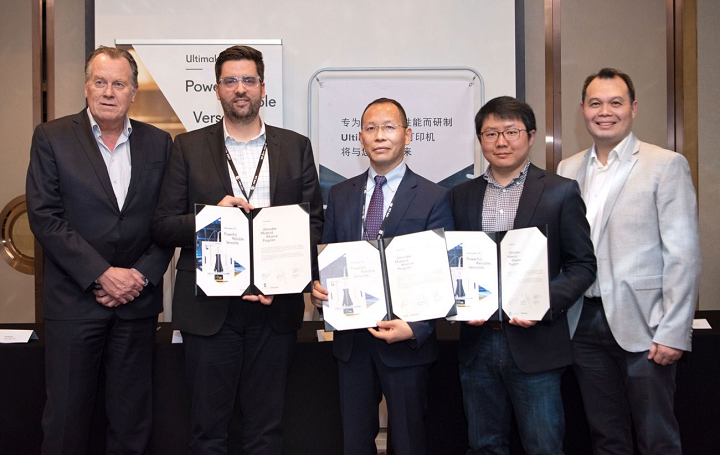
L-R: From Jos Burger, CEO Ultimaker; Dr. Blake Teipel, CEO Essentium; Dr. Yihu Yang, CEO eSUN; Dr. Xiaofan Luo, President Polymaker; Benjamin Tan, VP APAC Ultimaker
Each new member of the alliance brings something important to the table. For instance, recycling is a topic that’s widely discussed around the world, and it seems like helpful initiatives are popping up all over.
“We are specialized in the industrialization of biodegradable polymers. We are delighted to join the Ultimaker Materials Alliance Program with material print profiles of PETG, ePA-CF, and HIPS (High Impact Polystyrene), since it allows us to speed up the development of eco-friendly 3D printed products by using renewable resources,” said eSUN’s CEO Dr. Yihu Yang.
So engineers in the electronics industry can benefit from FFF 3D printing, the materials used must be ESD safe. Now, print profiles in the Ultimaker Marketplace are available with just these properties.
“At Essentium we are committed to creating industrial solutions for the world’s top manufacturers and bridging the gap between 3D printing and machining. We have partnered with BASF, the world’s largest chemical producer, to create the Ultrafuse-Z line, which is a series of ESD safe filaments that are powered by Essentium,” explained Dr. Blake Teipel, CEO of Essentium. “We offer material print profiles for Ultrafuse-Z PCTG in the Ultimaker Marketplace, an industrial grade filament that is specifically formulated to be ESD safe.”
Discuss this news and other 3D printing topics at 3DPrintBoard.com or share your thoughts in the Facebook comments below.
[Source/Images: Ultimaker]
Airbus Chooses Ultimaker 3D Printers for Desktop Use in European Facilities
 As a pioneer in the aerospace industry, the Airbus has used 3D Printing in creating parts for flight controllers, cabin parts, helicopter parts, along with combining robotics in other collaborations—of which there have been many in the past few years. Now, Airbus continues their ventures into 3D printing with Ultimaker known for desktop 3D Printers that are popular with users from the individual to the industrial level.
As a pioneer in the aerospace industry, the Airbus has used 3D Printing in creating parts for flight controllers, cabin parts, helicopter parts, along with combining robotics in other collaborations—of which there have been many in the past few years. Now, Airbus continues their ventures into 3D printing with Ultimaker known for desktop 3D Printers that are popular with users from the individual to the industrial level.
Airbus has chosen a range of Ultimaker 3D printers, Cura software, and materials for use in their European facilities fabricating local parts such as:
- Tools
- Jigs
- Fixtures
- Lightweight design parts
With a reputation that precedes them in terms of reliability and versatility, Ultimaker was chosen as the 3D printer of choice for Airbus due to their requirements for ease in use, dependable results, and open-source technology. Services and support will play a big role in the choice of Ultimaker too, as they promise to deliver in terms of ensuring consistency and ultimately, product quality for all of their teams involved—not only in Europe, but in other Airbus facilities around the globe too. So far, they will be awaiting delivery of Ultimaker S5 3D printers, along with corresponding software, material, parts, services, and peripheral features.
“We are very proud that Airbus selected Ultimaker. Strict rules regarding safety and certifications can make manufacturing and model-making workflows complicated, especially for engineers in the aerospace industry,” said Jos Burger, CEO at Ultimaker. “I am glad that our certified solution and the possibility to print with composite materials, enables these engineers to keep innovating. The team at Airbus can fully rely on our dedicated global sales and partner network for full support.”
While enormous industrial companies like Airbus are choosing Ultimaker for serious tasks at the desktop, other users around the world are making strides in science with complex shape shifting geometries, fabrication of prosthetics for children in third-world countries, and using this hardware for new learning endeavors in STEAM education.
Headquartered in the Netherlands, Ultimaker was founded in 2010 and is an OEM that also develops software with its Cura platform.
Ultimaker maintains other offices also as they maintain a growing and international presence from New York to Boston to Singapore, along with other production facilities in both Europe and the US. Currently, around the world, Ultimaker employs over 400 individuals.
What do you think of this news? Let us know your thoughts; join the discussion of this and other 3D printing topics at 3DPrintBoard.com.
Airbus ramps up 3D printing with Liebherr and Ultimaker
3D Printing Industry Awards 2019 Materials Company of the Year Update
2019 3D Printing Industry Awards: Personal 3D printer of the year (FFF) nominations update
Interview with Dynamism and Desktop Metal on the Ultimaker S5 and DM Studio System
Dynamism has been a retailer of 3D printing technology for over two decades, and the company always does well at keeping up with the latest, most talked-about 3D printers. Currently, one of its featured products is the Ultimaker S5, which was released last year and designed for industrial 3D printing. Another is the Desktop Metal Studio System, released in 2017 and designed for metal 3D printing in an office setting. Both systems exemplify two of the largest trends in 3D printing, more sophisticated desktop systems and binder jetting metals. Dynamism itself is at a crossroads as well. We’ve been talking to resellers around the world these past weeks to figure out what the 3D printing market is like for resellers today. What is a reseller to do? Do they move towards industrial or wait for the consumer market to grow? Dynamism gives us some interesting insight that points to them not only becoming more of business-focused firm but also looking at being more of an integrator.
Both the Desktop Metal and Ultimaker 3D printers have made a big impact on the 3D printing industry since their respective releases, and Dynamism is excited about their futures as well as its own. Recently both were showcased at CES, which wrapped up last week. We were able to talk with Dynamism CEO Douglas Krone about the Ultimaker S5 and its role in manufacturing.
Do you believe that the S5 will be used for manufacturing? What is holding it back from manufacturing now?
“On this point, I’d to point out that both the Ultimaker 3 and S5 are already widely used in manufacturing globally, for producing tools, jigs and fixtures.
To talk about end parts, are early use cases of customers printing end parts used in low volume products like machines or robots—grippers on robotics is a prime example. In these cases companies have looked at their BOMs (Bill of Materials) and found non-critical parts, often replacing metal with advanced 3D printed plastic. This provides short terms savings, but an even larger long-term advantage: far more efficient spare part production, though the life cycle of the product, and beyond. (Even after products are discontinued, companies must maintain a spare parts inventory—usually for years.)
I think that’s where Ultimaker’s Open Material strategy is a big win. These machine/robot producers require specific materials from leading chemical companies (certification, procurement risks) not from 3DP producers themselves (with the resulting lock in). Having said this, Ultimaker is focused prototyping, tools, low volume production and spare parts made on location.”
Do you foresee people using Ultiwalls (clusters of desktop printers) to manufacture parts? Will you need to automate more things on the printer or Ultiwall? Such as part removal?
“The current S5, and what we expect to see next from Ultimaker (the next-generation of ‘concrete floor’ machines), can be deployed in wall-formations. (And Cura’s CuraConnect supports that use.) But space, health, and safety requirements differ so much per factory and country, it would not make sense for Ultimaker to do a standard ‘Ultiwall’ product. You can expect 3D printing solutions providers like Dynamism to create these types of customized arrangements for larger customers.”
What are instances of Ultimaker adoption in the automotive industry?
“We see almost every automotive company, not just OEMs, but also in second, third and fourth tier now using Ultimaker. Uses are part development, tool design, and tool production. Ford and Volkswagen have especially impressive showcases.”
Are there any product announcements or other news from the show?
“The next news we expect from Ultimaker will be later this year. Look for innovative accessories that will work with all existing Ultimaker S5s, and make a great 3D printer even better. And of course Ultimaker is always iterating and improving Cura.”
To learn more about Desktop Metal’s Studio System, we spoke with Desktop Metal VP of Product Larry Lyons.
How well is the Desktop Metal Studio System doing?
“As our office-friendly systems are making their way to customers throughout the country, we recently announced the launch Studio System+ and Studio Fleet which together offer enhanced features for metal prototyping and low volume production. Engineers and designers who are looking to push the limits of metal 3D printing with small parts or parts with fine details can now achieve even higher-resolution, with a customizable system configuration for greater process efficiency and throughput right on the shop floor. The new Studio System+ retains all the key features of the original Studio System with advancements that allow customers to build to scale and offer high-resolution printing. Studio Fleet adds a custom-configurable, in-house metal 3D printing solution to support a variety of production scenarios and scales for a wide range of low- to mid-volume applications across industries. For the first time, on-demand metal 3D printing will be able to deliver accessible and scalable manufacturing that adapts to diverse business needs, part requirements, production volumes and cost constraints. We have received hundreds of reservations for our Studio System and are now shipping in volume to our customers in the USA. The Studio System is available in 45 countries, and we expect to begin international shipments in mid-2019.”
How well (and how) does the system compensate for shrink in all directions in different part sizes?
“Shrinkage is dependent on a number of factors, including alloy used, geometry of the part and size. As part of the Desktop Metal design, printing and sintering process, our software analyzes all of the factors that impact the approximate 18-20 percent shrinkage and automatically adjusts scaling factors in each dimension to yield the intended part size.”
How much can one Desktop Metal Studio System make?
“With one Studio System printer, 12” x 8” x 8” is the maximum build volume, so any part that fits in that box can be printed. The Studio printer has a maximum print rate of 1 in 3/hr so the throughput of parts printed depends on the volume of the part you are printing. The debinder and furnace have the same build volume, but offer adjustable trays to batch process many parts at once, which is exemplified by our Studio Fleet offering.
For customers needing a higher throughput, Studio Fleet is a custom-configurable solution for in-house metal 3D printing—supporting a range of applications for low to mid-volume production. Built to scale, it leverages Studio System+ technology—including a software-controlled workflow and stackable shelving for batch processing—for the rapid production of high-quality, complex metal parts. For the first time, on-demand metal 3D printing will deliver accessible and scalable manufacturing that adapts to diverse business needs, part requirements, production volumes, and cost constraints. The Studio Fleet is available to be built in two configurations:
-
3:1:1 – With 3 printers + 1 debinder + 1 furnace, customers can realize a 300 percent improvement in throughput for only a 50 percent increase in system cost.
-
5:2:1 – With 5 printers + 2 debinders + 1 furnace, users will be able to realize 500 percent improvement in throughput for only a 100 percent increase in system cost.”
For automotive, what kinds of parts are your customers targeting?
“Our automotive customers are targeting parts across all stages of product life cycle. For Studio, most applications are in the product development, prototyping and tooling (jigs/fixtures/molds) areas where lower volumes and quick turnaround times match well with the Studio’s capabilities. For the Production System, which will be available to ship in 2019, early applications we are seeing are in the replacement / aftermarket parts, customization and serial production where volumes requirements range from mid-to-high throughput. Many customers are developing end-use parts that will appear in new cars that have yet to hit the market and will deliver higher performance at a lower cost than the traditional manufactured alternative in today’s cars.”
How much faster is it than MIM? How much cheaper is it than MIM?
“For the Studio System, the time it takes to produce the initial part is 2-3 days. This compares to several weeks or even months with MIM due to the mold that needs to be designed and manufactured before the MIM process can begin. This allows customers to dramatically accelerate the time it takes to get an initial prototype for testing and validation work compared to the traditional MIM process. It also allows customers to iterate on their design and test each iteration before ordering the mold to be manufactured, which can save thousands in costly mold changes if a change is needed.
Because of the expense associated with manufacturing the mold in MIM, most MIM companies will not bid on any job that is less than 10,000 units due to the mold cost making the parts too expensive. The Studio System provides a more cost-effective solution for low-to-mid volume applications in the MIM industry, especially when leveraging the throughput and cost advantages of a Studio Fleet installation.”
What kinds of part sizes can I reliably print with the Desktop Metal Studio?
“With the Studio System printer, 12″ x 8” x 8” is the maximum build volume, so any part that fits in that box can be printed. In addition, we recently introduced a new swappable high resolution printhead with supporting software profiles allows for smaller parts with finer features and animproved surface finish. This creates opportunities for new geometries and applications with the ability to print parts similar to those produced with metal injection molding (MIM)—parts featuring sintered voxels as tiny as 240um in XY by 45um in Z, which is smaller than a grain of table salt—making it ideal for a variety of applications such as parts for consumer electronics, medical devices and automotive.”
Discuss this and other 3D printing topics at 3DPrintBoard.com or share your thoughts below.
10 Ways 3D Printing Played a Part in Education in 2018
3D printing is often used in education these days, whether it’s being taught as a subject or used to enhance another one. As we’re moving ever closer to the start of a new year, we decided to save you some time and gather the ten best education stories from 2018 in one article.
Siemens STEM DAY
The Siemens Foundation focuses on philanthropic efforts in order to continue the advancement of STEM-related education and workforce development, and has invested millions of dollars for this cause in the US. In early 2018, the Siemens Foundation worked with Discovery Education to re-brand its annual Siemens Science Day into a program for more modern educational opportunities: Siemens STEM Day, which is an opportunity for US schools to promote STEM activities for both students and teachers. The program, which doesn’t actually happen on one specific day but is a promotion of STEM lessons and hands-on activities, is meant to be used by students in grades K-12, and offers multiple tools and resources to help reboot STEM curriculum.
New 3D Printing Educational Initiatives
In February, we provided a round-up of some of the many educational initiatives that were looking to provide adults with a deeper understanding of 3D printing. Included in this round-up was a new online course for professionals by MIT, new 3D printing courses from the Sharebot Academy program, and a joint two-day training course in additive manufacturing from German consulting firm Ampower and full service prototyping and 3D printing provider H & H. Additional educational initiatives shared in the round-up were 3DPrint.com’s own Additive Manufacturing with Metals Course.
learnbylayers Partnered with Kodak
In 2017, educator Philip Cotton launched an online 3D printing resource for teachers called learnbylayers that offers lesson plans, project ideas, assessments and more that were designed by teachers for teachers. The site grew quickly, and in February Cotton announced that it had reached a distribution agreement with Kodak. The learnbylayers educational curriculum was added to the Kodak 3D Printing Ecosystem, as the company began offering the internationally-taught curriculum along with its Portrait 3D printer’s launch.
Renishaw Deepened Its Commitment to 3D Printing Education
This spring, Renishaw announced that it would be deepening its commitment to 3D printing education. The company established a new Fabrication Development Centre (FDC) at its Miskin facility in South Wales, with the goal of inspiring young people to pursue STEM careers. The FDC has two classrooms, staffed by qualified teachers and Renishaw’s STEM ambassadors, that can be used for free by schools or groups of young people for lessons or workshops. The FDC was actually in use by Radyr Comprehensive School students long before it was officially launched by Andy Green, a driver for Bloodhound SSC, a 3D printing user and Renishaw partner which also devotes many resources to education about the technology.
Ultimaker Launched New 3D Printing Core Lessons for STEAM Education
In April, Ultimaker launched its new Ultimaker Core Lessons: STEAM Set for educators. Eight free lessons, published under a Creative Commons Attribution-ShareAlike 4.0 International License, are included in the set, which can help teachers in informal, K12, or Higher Ed classrooms incorporate 3D printing into their educational practices and STEAM curriculum. Some of the beginner lessons include 3D printing a coin trap, flashlight, and penny whistle, and can teach young students important skills like how to align objects, using symbols to communicate ideas, and how to effectively work together on creative projects.
PrintLab Teamed Up with CREATE Education Team
UK-based global 3D printing distributor and curriculum provider PrintLab partnered with UK 3D printing company CREATE Education, a collaborative platform that provides educators with free resources and support, in order to support schools all across the UK with 3D printing. Each company’s educational 3D printing offerings will be combined in this partnership so that UK schools can enjoy unlimited access to full 3D printing solutions for the classroom, which will be locally supported for life by CREATE. Multiple initiatives came out of this partnership to support teachers, like 3D printer loan schemes, funding advice and resources, special training and curriculum workshops, and new educational 3D printing bundles.
3Doodler Introduced New Educational Kits
3Doodler has long supported education, and often releases new STEM-centered educational packages, including its latest classroom product line: the 3Doodler Create+ EDU Learning Pack and 3Doodler Start EDU Learning Pack. Each pack, designed for and with teachers, was designed specially for classrooms from kindergarten to 12th grade and includes 6 or 12 3Doodler pens (Create or Start, depending on the package) and 600 or 1,200 strands of plastic, as well as other tech accessories, lesson plans, and classroom materials. Additionally, the company released its 3Doodler Create+ EDU Teacher Experience Kit and 3Doodler EDU Start Teacher Experience Kit, which are designed to be trial packs for teachers who are thinking about introducing the 3Doodler into their classrooms.
Robo Acquired MyStemKits
3D printer manufacturer Robo announced this summer that it had acquired Atlanta company MyStemKits, which provides the largest online library of STEM curriculum in the world. Thanks to this acquisition, Robo is now offering educational bundles that include its classroom-friendly 3D printers, a supply of filament, one-year subscriptions to MyStemKits, and additional professional development and online learning.
GE Additive’s Education Program Provided Five Universities with Metal 3D Printers
GE’s Additive Education Program (AEP) – a five-year, $10 million, two-part initiative to provide 3D printers to as many schools as possible – chose five universities this summer to receive an Mlab 200R from the program. 500 proposals were submitted for this round of the program, and GE Additive chose German’s Coburg University of Applied Sciences and Arts, Ireland’s University of Limerick, the Calhoun Community College in Alabama, the University of Illinois at Urbana-Champaign, and West Virginia University as the lucky winners.
3D Printing In Fashion Education
In a recently published paper, titled “Integration of 3 Dimensional Modeling and Printing into Fashion Design Curriculum: Opportunities and Challenges,” Nicole Eckerson and Li Zhao from the University of Missouri discussed whether 3D printing should be integrated into fashion design curriculum. The researchers noted that while 3D printing has been recognized as a major influence in the work of designers and engineers, educators in the fashion industry are facing a lack of time, resources, and knowledge to teach the technology to students. The two conducted semi-structured interviews with eight 3D printing industry experts and academic professionals for their research, and came up with three distinct themes from their data about why 3D printing should be adopted, and taught, in fashion.
Discuss this and other 3D printing topics at 3DPrintBoard.com or share your thoughts below.

